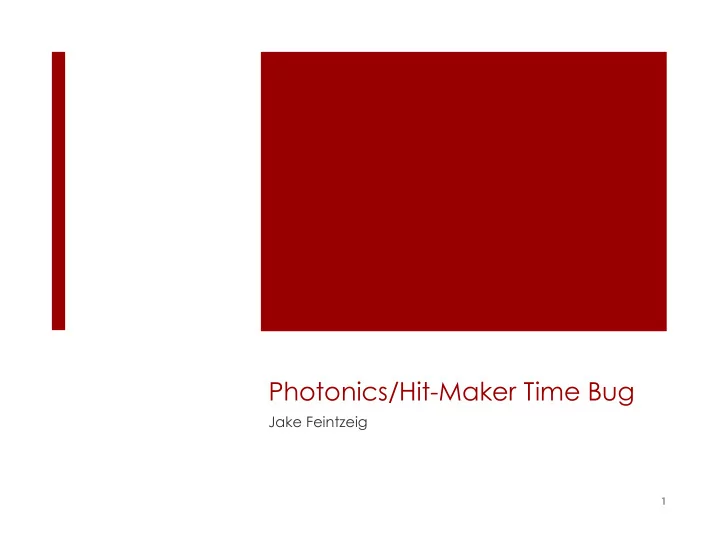

Photonics/Hit-Maker Time Bug Jake Feintzeig 1
2 Contents This talk covers two separate but related bugs, one in photonics and one in hit-maker Photonics time transformation bug Overview Details Time transformation plot Example Summary and solution Hit-maker bug Details Summary and solution
3 Photonics Time Bug - Overview Photonics bug affects: anything that uses time pdfs/cdfs with level2 tables Simulation and reconstruction of muons Hit-maker Photorec Not finiteReco, surprisingly Not millipede (uses level 1) The bug is a systematic timing offset that varies with track-DOM distance, but is on the order of 10 ns
4 The Details In the level 2 tables reading routine, photonics does a time transformation to “internal residual time format” that depends on the difference between the internal table group velocity (what was simulated) and the external IceCube group velocity…yes, they’re different In place to ensure there are no negative time residuals, since photons of different wavelengths propagate at different speeds The result is a time shift is added or subtracted depending on whether you ask photonics for a Time or a Probability Everything is very confusing The bug is a math error in the time shift calculation
5 Discrepancy Varies with Distance
6 Example - Simulation -> Hit-maker asks photonics: Given a source and receiver configuration, how far after the IceCube geometric time will a photon arrive? • Let’s say t geo = 500 ns in IceCube convention IceCube t delay = ? 500 ns muon
7 Example - Simulation -> Hit-maker asks photonics: Given a source and receiver configuration, how far after the IceCube geometric time will a photon arrive? • Let’s say t geo = 500 ns in IceCube convention • Photonics table has delay times w/r/t the geometric time of the fastest photon , which has a t geo < 500 ns in Photonics IceCube Photonics t delay = ? 500 ns 488 ns muon
8 Example - Simulation -> Hit-maker asks photonics: Given a source and receiver configuration, how far after the IceCube geometric time will a photon arrive? • Let’s say t geo = 500 ns in IceCube convention • Photonics table has delay times w/r/t the geometric time of the fastest photon , which has a t geo < 500 ns in Photonics • To account for this, photonics transforms the time from the table into IceCube’s convention IceCube Photonics t delay = 38 t delay = 50 500 ns 488 ns muon
9 Summary and Solution For much of our data (tracks ~ 100m from DOMs), the bug in the time shift is on the order of ~10 ns The bug is easily fixed - plan is to cut a new release of photonics and update i3ports
10 Hit-maker bug Photonics subtracts time when it returns a time delay, and shifts a pdf forward when it returns a probability (essentially adding time) In binning mode, hit-maker uses I3PhotonicsService::GetTimeDelays() for DOMs with hits below a certain PE threshold, and GetProbabilityDensity() for DOMs above threshold Hit-maker can miss early charge Asks for probability starting at time=0 (IceCube), which gets transformed to time>0 in Photonics
11 Discrepancy Varies with Distance Hit-maker is off by this amount
12 Hit-maker bug solution One possible solution: implement inverse time- transformation in hit-maker to get correct start time Instead of asking for probability starting at t=0, hit-maker will ask for probability starting at the correct negative time Nathan Whitehorn will do this when he rewrites hit-maker
Recommend
More recommend